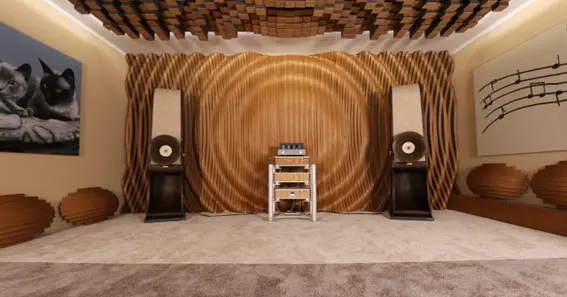Achieving superior sound quality in a music room requires careful attention to acoustics, particularly at first reflection points. These are areas where sound waves first bounce off surfaces before reaching the listener, potentially causing phase issues and blurring the audio image. Implementing the best diffuser for first reflection points can effectively mitigate these problems, leading to a more accurate and immersive listening experience.
Understanding First Reflection Points
First reflection points are the initial spots where sound waves from speakers reflect off walls, ceiling, or floor before arriving at the listening position. These reflections can interfere with the direct sound, causing comb filtering and diminishing clarity. Identifying and treating these points is crucial for optimal room acoustics.
Diffusion vs. Absorption at First Reflection Points
Traditionally, absorption materials have been used at first reflection points to eliminate unwanted reflections. However, excessive absorption can lead to a “dead” room lacking natural ambiance. Diffusers scatter sound waves in various directions, preserving energy and maintaining a lively atmosphere. Incorporating diffusion at first reflection points can balance clarity with natural reverberation.
Types of Diffusers Suitable for First Reflection Points
- Quadratic Residue Diffusers (QRD):QRDs are designed based on mathematical sequences to scatter sound waves uniformly. They are effective across a broad frequency range and are commonly used in professional studios.
- Skyline Diffusers:Featuring a three-dimensional pattern resembling a city skyline, these diffusers scatter sound in both horizontal and vertical planes, providing comprehensive diffusion.
- Fractal Diffusers:Combining multiple diffusion techniques, fractal diffusers offer effective scattering across a wide frequency spectrum, making them suitable for critical listening environments.
Selecting the Best Diffuser for Your Music Room
When choosing a diffuser for first reflection points, consider the following factors:
- Frequency Range: Ensure the diffuser effectively scatters frequencies relevant to your room’s usage, typically mid to high frequencies.
- Material and Build Quality: High-quality materials like wood or specialized acoustic foam enhance durability and performance.
- Aesthetic Integration: Select designs that complement your room’s aesthetics without compromising functionality.
- Space Availability: Consider the size and depth of the diffuser, ensuring it fits appropriately within your room’s dimensions.
Installation Tips
- Identify First Reflection Points: Use the mirror trick—have someone move a mirror along the walls; wherever you see the speaker’s reflection from your listening position is a first reflection point.
- Placement: Install diffusers at these points on side walls, ceiling, and rear wall to effectively scatter reflections.
- Combination with Absorption: In some cases, combining absorption and diffusion can yield optimal results, especially in smaller rooms.
FAQ
1. Can I use diffusers at all first reflection points?
Yes, but it’s essential to assess your room’s acoustics. In smaller rooms, a combination of absorption and diffusion may be more effective.
2. How do I choose between QRD and Skyline diffusers?
QRD diffusers are suitable for larger areas and offer uniform diffusion, while Skyline diffusers are effective in smaller spaces due to their multidirectional scattering.
3. Can I build my own diffusers?
Yes, DIY diffusers are feasible with proper materials and designs. However, ensure they are constructed accurately to achieve desired acoustic results.
4. Will diffusers eliminate all acoustic issues?
No, diffusers address specific reflection problems. Comprehensive acoustic treatment may also involve bass traps and absorbers.
5. How do I maintain diffusers?
Regular dusting and ensuring they remain securely mounted are typically sufficient for maintenance.
Incorporating the best diffuser for first reflection points in your music room is a strategic approach to enhancing sound clarity and preserving natural ambiance. By carefully selecting and installing appropriate diffusers, you can create an acoustically balanced environment conducive to critical listening and recording.










